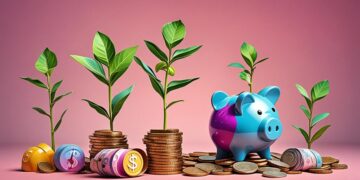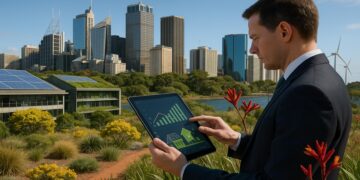Sustainable Investment Trends in Australia: The Future of Green Finance

Understanding the Shift Towards Sustainable Investments
In recent years, Australia has witnessed a remarkable shift towards sustainable investments. These investments not only focus on financial returns but also prioritize environmental and social impact. This evolving landscape reflects a growing awareness of the importance of sustainability in finance, driven by both individual and collective actions aimed at addressing pressing global challenges such as climate change and social inequality.
The following trends are shaping the future of green finance in Australia:
- Increased Demand for Ethical Investments: There is a noticeable shift in investor behaviour, particularly among millennials and Gen Z. These generations are more inclined to invest in companies that align with their personal values. For instance, ethical funds that focus on renewable energy or sustainable agriculture have become increasingly popular, as investors seek to avoid sectors like fossil fuels or tobacco that do not resonate with their ethical beliefs.
- Government Initiatives: Australia’s government is taking proactive steps to promote sustainability. Policies aimed at reducing carbon emissions and encouraging clean energy investments are being rolled out. The recent commitment to achieving net-zero emissions by 2050 is a prime example. Furthermore, initiatives like the Australian Renewable Energy Agency (ARENA), which funds innovative energy projects, exemplify the government’s focus on fostering a sustainable economy.
- Corporate Responsibility: Corporate social responsibility (CSR) is becoming vital for businesses in Australia. Companies are under increasing pressure from consumers to demonstrate their commitment to sustainability. For example, large retailers such as Woolworths have implemented measures to reduce their carbon footprint, including reducing plastic use and promoting local produce. When firms prioritize sustainability, they not only improve their public image but also attract socially conscious investors.
These trends indicate a significant transformation in how financial markets operate. The rise of green bonds, which fund projects aimed at environmental benefits, and impact investing, where investors seek socio-environmental returns alongside financial gains, exemplifies this change. Additionally, the integration of ESG (Environmental, Social, and Governance) criteria into investment assessments is gaining traction across sectors, helping investors make informed decisions based on sustainability metrics.
Ultimately, the future of green finance in Australia is not just about the flow of capital; it’s about creating a sustainable legacy for generations to come. As these trends continue to evolve, they pave the way for innovations and ideas that will support the development of a more sustainable economy. Investment in these areas not only promises financial returns but also contributes to a healthier planet, leading to a win-win situation for both investors and society at large.
Navigating the Landscape of Sustainable Investments
The sustainable investment landscape in Australia is expanding rapidly, driven by a combination of changing consumer preferences, regulatory support, and innovative financial products. To better understand this shift, it is essential to explore key aspects that are influencing the future trajectory of green finance.
The Role of Green Bonds
Green bonds are at the forefront of sustainable financing, attracting investors keen to fund projects with environmental benefits. These fixed-income securities are used specifically to raise funds for initiatives that aim to tackle climate change and promote sustainable development, such as renewable energy, sustainable transport, and clean water. In Australia, there has been a notable increase in the issuance of green bonds; for instance, the Climate Bond Initiative reported that in 2021 alone, Australian green bond issuance exceeded AUD 10 billion. This growth suggests a growing appetite among institutional and retail investors keen to support sustainable projects while achieving respectable returns.
Impact Investing: A New Frontier
Alongside green bonds, impact investing is carving out a significant niche within the sustainable investment space. This approach deliberately seeks to generate measurable social and environmental impact alongside a financial return. An example of impact investing in Australia would be funds dedicated to social housing projects aimed at addressing homelessness or educational programs focused on disadvantaged communities. By choosing to invest in companies and initiatives that aim to create positive change, impact investors help drive additional capital towards critical social causes, aligning financial goals with broader societal benefits.
The Emergence of ESG Criteria
Another pivotal trend influencing sustainable investments is the integration of Environmental, Social, and Governance (ESG) criteria into investment decision-making processes. ESG metrics allow investors to evaluate companies based on their sustainability practices, providing insight into their long-term viability and ethical stance. This holistic approach to assessing a company’s performance encourages firms to adopt sustainable practices. For instance, superannuation funds in Australia are increasingly evaluating potential investments using ESG criteria, thus holding companies accountable for their environmental practices and social responsibility. Research from the Responsible Investment Association of Australia indicated that approximately 50% of Australians are interested in knowing whether their super funds are invested responsibly and sustainably.
Growing Awareness and Education
As awareness of climate change and social injustices grows, education around sustainable finance is becoming increasingly important. Many Australian universities are now offering specialized courses on sustainable finance and investment strategies, empowering the next generation of investors with the knowledge needed to navigate this evolving field. Additionally, community-based initiatives and workshops frequently educate individuals on the benefits of sustainable investing, highlighting how individual choices can contribute to a larger impact.
In summary, sustainable investments in Australia are evolving dramatically, driven by the integration of green bonds, impact investing, ESG criteria, and heightened awareness among investors. This transformation not only reflects a changing mindset towards investment but also holds the potential to reshape the future of finance in ways that prioritize the health of our planet and the well-being of our communities.
The Impact of Government Policy and Regulation
The role of government policy in shaping the sustainable investment landscape in Australia cannot be overstated. Recent years have seen the introduction of various initiatives aimed at promoting green finance and encouraging responsible investment practices. The Australian government has committed to achieving net-zero emissions by 2050, a goal that necessitates massive investment in renewable energy and other sustainable sectors.
Policies such as the Clean Energy Finance Corporation (CEFC) and the National Climate Resilience and Adaptation Strategy are crucial in directing capital towards projects that align with these sustainability goals. The CEFC has invested billions in clean energy projects, offering support for renewable infrastructure and energy efficiency measures. These government-backed initiatives not only provide funding but also create a favorable environment for private sector investment, helping to mobilize the necessary financial resources for Australia’s clean energy transition.
Corporate Sustainability Reporting
Another significant trend emerging in Australia is the shift toward corporate sustainability reporting. As investors increasingly demand transparency regarding companies’ environmental and social impacts, businesses are starting to disclose more comprehensive information related to their sustainability practices. For example, the introduction of the Task Force on Climate-related Financial Disclosures (TCFD) reporting framework encourages Australian companies to assess and disclose their climate-related financial risks and opportunities.
Such reporting not only assists investors in making informed decisions but also encourages companies to adopt more sustainable practices to remain competitive. A growing number of Australian firms, including major players in the resources and finance sectors, are beginning to publicly report their ESG metrics. This trend is empowering investors to choose businesses that align with their values and promoting a culture of accountability and responsibility among corporate leaders.
The Rise of Ethical Investment Funds
Additionally, the popularity of ethical investment funds is on the rise. These funds focus on investing in companies that meet specific ethical criteria, often excluding sectors such as fossil fuels, tobacco, and gambling. The increased interest in ethical funds reflects a broader cultural shift towards responsible consumption and investment practices among Australians. For example, many superannuation funds now offer ethical investment alternatives, allowing members to choose funds that align with their values.
- Australian Ethical Investment and Future Super are notable examples of funds dedicated to responsible investment practices.
- These funds aim to deliver competitive financial returns while ensuring that investments have a positive impact on society and the environment.
The emergence of these investment products demonstrates that investors no longer have to compromise on their values to achieve financial returns. Instead, there is a growing recognition that sustainable investments can also protect and enhance financial portfolios in the long term.
Collaboration Across Sectors
Lastly, cross-sector collaboration is becoming increasingly vital in promoting sustainable investments in Australia. Initiatives bringing together governments, businesses, and NGOs are fostering partnerships that can effectively tackle complex sustainability challenges. An example of this collaborative approach is the Green Building Council of Australia, which works with property developers, architects, investors, and government bodies to promote sustainable building practices.
This holistic collaboration helps to create a more unified approach to sustainable investment, as diverse stakeholders contribute their expertise and resources towards common sustainability goals. By working together, these entities can amplify their efforts, resulting in more impactful and far-reaching outcomes that benefit both the environment and society.
Conclusion
In conclusion, the landscape of sustainable investment in Australia is rapidly evolving, driven by a strong commitment to environmental stewardship and social responsibility. Key trends such as the impact of government policy and regulation, increasing corporate sustainability reporting, the rise of ethical investment funds, and enhanced collaboration across sectors are shaping a future where green finance becomes a cornerstone of the economy.
As the Australian government sets ambitious targets, such as achieving net-zero emissions by 2050, the demand for capital directed towards renewable energy and sustainable projects is more crucial than ever. The establishment of frameworks like the CEFC and the TCFD is not only fostering transparency but also empowering investors to make informed choices that align with their values.
Furthermore, the increase in ethical investment options reflects a cultural shift among Australians towards responsible financial practices, showing that it is possible to pursue financial returns without compromising one’s principles. The growing trend of cross-sector collaboration also highlights the importance of shared responsibility in addressing complex sustainability challenges.
As we move forward, embracing these sustainable investment trends will not only bolster economic resilience but also contribute to a healthier planet. By continuing to support and adopt green finance initiatives, Australia can lead the way in building a more sustainable future for generations to come, proving that good financial sense and environmental responsibility can go hand in hand.

James Carter is a financial writer and advisor with expertise in economics, personal finance, and investment strategies. With years of experience helping individuals and businesses make complex financial decisions, James offers practical insight and analysis. His goal is to give readers the knowledge they need to achieve financial success.






